List of conflicts in the Philippines
This list of conflicts in the Philippines is a timeline of events that includes pre-colonial wars, Spanish–Moro conflict, Philippine revolts against Spain, battles, skirmishes, and other related items that have occurred in the Philippines' geographical area.[1]
List
| conflict | Combatant 1 | Combatant 2 | Results |
|---|---|---|---|
| Ancient times | |||
| Highlander clans and tribes against low-land warlords (500 BCE) | Clans and tribes of Ifugao (highlanders) | Warlords of Kalinga (low-landers)
|
Unification of the clans and tribes makes the entire society of Cordillera. |
| Classical period (Precolonial era) | |||
| First Visayan Raid -(Formosa, East China Sea -c. 1174 AD)[2] | Confederation of Madja-as
|
Song Dynasty | Successful raiding expedition[3] |
| Second Visayan Raid -(Formosa, East China Sea -c.1190 AD)[2] | Confederation of Madja-as
|
Song Dynasty | Successful raiding expedition[4] |
| Expedition (c. 1200 CE) |
|
|
Regime changed, foundation of Tondo |
| Expedition- Expansion of Tondo Kingdom c. 1220 (High Middle Ages) |
Kumintang (cheifdom in Batangas). | Fall of Batangas Province to the Tundun Regime | |
Expedition-Expansion of Tondo Kingdom c. 1221 (High Middle Ages) Tagalog couple from the Maharlika nobility. |
Chiefdoms tribes and clans of Ilocos, Pampanga | The Provinces of Ilocos Region, Pampanga become part of the Tondun Regime. | |
Expedition- Expansion of Tondo Kingdom c. 1225 (High Middle Ages) A Warrior armed with a gun. |
Chiefdoms tribes and clans of Bicol | The Bicol Peninsula becomes part of the Tundun Empire. | |
Rebellion (1300 CE.)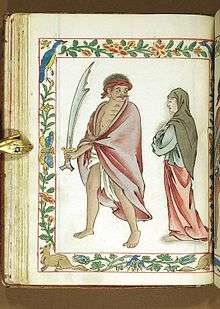 the Timagua were the feudal warrior class of the ancient Visayan societies of the Philippines. |
Singhapala (Cebu)
|
Establishment of the Rajahnate of Cebu[5] | |
| Battle of Manila (1365) Majapahit-Luzon conflict | Kingdom of Tondo
|
Majapahit
|
Decisive victory Unspecified and disputed battle [6] according to the text Nagarakretagama. |
| Moro raid - Po-ni provine (modern day Brunei-1369 AD) | Sultanate of Sulu
|
Majapahit Empire
|
Majapahit succeeded in driving away the Sulu [7] |
| Moro raid: Invasion of Palawan - Expansion of Bruneian Empire (Ca. 1477 CE.) Moro Pirates. |
Clans and tribes in Palawan
|
Bruneian Empire
|
The Island of Palawan was annexed by the Brunei.[8] |
| Moro raid: Fall of Huangdom - Expansion of Bruneian Empire Mindoro c. 1500 C.E. |
Fall of Huangdom.
| ||
Moro raid:Brunei invasion of Tondo -Expansion of Bruneian Empire c.(1500 CE.)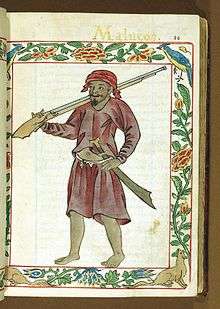 A Malay warrior armed with gun and a sword. |
|
Fall of Tondo. Foundation of Kota Selurong (Maynila), a vassal state of Kingdom of Brunei.[10][11]
| |
| Expeditions (ca. 1400 CE.) | Kingdom of Butuan | Confederation of Madja-as | fall of the Butuan Rajanate |
Expeditions (ca. 1440 CE.) A Karakowa ancient Battleship with Lantaka Cannons. |
Confederation of Madja-as
|
Madja-as victory[12]
| |
| Expeditions (ca. 1450 CE.) | Confederation of Madja-as
|
Madja-as victory[12] | |
| Expeditions (ca. 1457 CE.) | Confederation of Madja-as
|
Chinese pirates | Madja-as victory[12]
|
| Muslim expansion of mindanao- Battle of Malabang, Lanao del Sur , 1475 AD. |
|
Non-Muslim natives | Sultanates victory[13] |
Coalition (1500 CE.) A Visayan Royal couple. |
Confederation of Madja-as Kedatuan of Visayas: |
Alliance of the Kota Selurong (Maynila) Kingdom of Namayan Sponsored by :
|
Madja-as victory
|
| Battle of Mactan (1521)  |
Chiefdom of Mactan Island King Lapu Lapu of Cebu |
Filipino tribal allies |
Victory death of Magellan, departure of the Spanish expedition |
Burmese–Siamese War (1547–49) 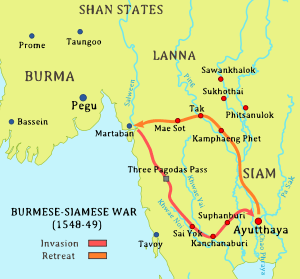 |
Toungoo Dynasty (Burma) | * Siamese defensive victory Burma claims to regain Upper Tenasserim down to Tavoy (Dawei). * At the same time, Lusung warriors fought alongside the Siamese king.[15] Also,Lucoes warriors aided the Burmese king in his invasion of Siam in 1547 AD.[16] | |
| Colonial Period | |||
| Spanish Conquest (1571) |
Kingdom of Namayan Empire of Tondo Kingdom of Maynila Confederation of Madja-as |
|
Fall of the Luzon and Visayan Kingdoms. Establishment of Spanish colonial territories in Luzon and islands of Visayas.[17] |
| Philippine revolts against Spain | |||
| Dagami Revolt (1565) |
Chief Dagami of Gabi Rajah Tupas |
|
Ceasefire
|
| Spanish campaigns in Lanao (1637–1639 CE) | Sultanate of Lanao
|
|
Spanish defeat
|
| Conspiracy of the Maharlikas (1568) |
Sponsored by
|
|
The uprising failed when they were betrayed to the Spanish authorities by Antonio Surabao (Susabau) of Calamianes.
The rebels were arrested, tried and found guilty of treason. Five leading members were exiled to Mexico: Pedro Balinguit (lord of Pandacan), Pitongatan (a prince of Tondo), Felipe Salonga (lord of Polo), Calao (a commander-in-chief of Tondo), and Agustín Manuguit (Minister of Tondo). They were the very first natives of the Philippines to settle in Mexico. |
| Cagayan Revolt (1565) |
Ilocanos, Ibanag tribes | |
Ceasefire Tax system reformed |
| Magalat Revolt (Cagayan Valley – 1596) | Chief Magalat of Cagayan |
|
defeat of rebellion Death of Magalat |
| Bruneian Civil war (1600-1673) |
|
|
|
| Igorot Revolt (Cordillera 1601) | Ifugao Clans and tribes |
|
Ceasefire
|
| Sumuroi Revolt (1649-1650) | Agustin Sumuroy |
|
defeat
|
| Battle of Manila (1762) (part of Seven Years' War) |
Spanish garrison of Manila | British fleet and army with troops from East India Company (William Draper) |
Manila and Cavite occupied by British until 1764 when treaty concludes war |
| Cavite Mutiny (1872) | Filipino workers Felipe Ginoves |
|
defeat |
Spanish Conquest of Mindanao (1888) The Moros on their proas. |
Maguindanao become part of the Spanish East indies | ||
| Philippine Revolution | |||
| Battle of Imus (Imus Cavite September 1–3, 1896) |
Victory
| ||
| Battle of Alapan (ImusCavite - 1898) | Victory
| ||
Battle of Barrio Yoting (Pilar Capiz, Visayas - December 3, 1898) the Katipuneros. |
victory | ||
Battle of Zapote Bridge (February 17, 1897)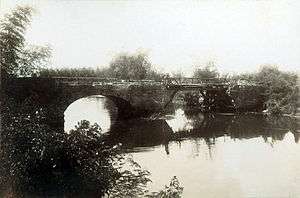 The Zapote Bridge (1899) two years after the battle. . |
Filipino victory | ||
| Philippine War of Independence (1895-1896)  Regular soldiers of the Philippine army stand at attention for the inspection. |
|
Signing of Pact of Biak-na-Bato. (1895) Establishment of First Philippine Republic with Emilio Aguinaldo as the first President
| |
| First Republic-Commonwealth Periods | |||
| Siege of Baler (Baler, Aurora July 1, 1898 – June 2, 1899) | Victory
| ||
| Battle of Balantang (Balantang, Jaro, Iloilo March 10, 1899) |
Filipino Victory
| ||
| Battle of Paye (December 19, 1899) |
Initial Filipino Victory | ||
| Battle of Pulang Lupa (1900) |
Filipino Victory | ||
| Battle of Mabitac (1900) 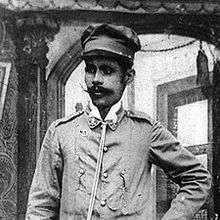 Gen.Juan Cailles. |
Filipino Victory | ||
| Siege of Catubig April 15–April 19, 1900 |
Filipino guerillas force US from town after 4 days but at high cost | ||
| Battle of Makahambus Hill June 4, 1900 |
Filipino victory | ||
| Battle of Tirad Pass[19] (December 2, 1899) 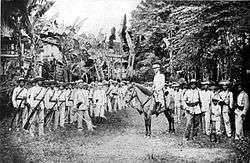 Gen.Gregorio del Pilar and his troops, around 1898. |
Defeat
| ||
| Philippine–American War 1900-1901 |
|
Fall of the First Republic
| |
| Second World war | |||
| Japanese invasion of the Philippines (1941-1942) Japanese occupation of the Philippines (1942-1944) Allied liberation of the Philippines (1944-1945)  Japanese Troops surrender to the 40th Infantry Division. |
|
|
Defeat
Retreat
Victory
|
| Battle of Bataan (January 7-April 9, 1942) Battle of Corregidor (May 5–6, 1942) |
|
|
Defeat
|
Battle of Manila (February 3-March 3, 1945) 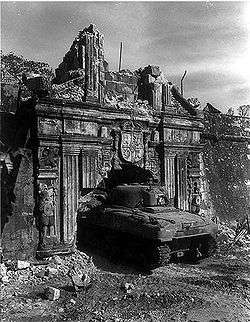 |
|
|
Allied victory
|
| Battle of Bessang Pass (June 14, 1945) | |
|
Victory
|
| Cold War era | |||
| Hukbalahap Rebellion (1942-1954) |
Philippine government victory
| ||
| 1969 - Present | |||
| Moro insurgency (March 29, 1969 – present) Operation Enduring Freedom in the Philippines (January 15, 2002 – ongoing)  M101 howitzer was widely use as the artillery in the operation against the Moro insurgencies in Mindanao. |
|
Cessation of armed conflict between the Government and MNLF/MILF
| |
| CPP-NPA-NDF rebellion (1969 - present)[20] | Indefinite Ceasefire declared | ||
| 1990 Mindanao crisis (October 4 – 6, 1990) |
|
Philippine government victory
| |
| Zamboanga City crisis (September 9–28, 2013) The Zamboanga City Hall where the MNLF intended to hoist the Bangsamoro Republik flag. |
Philippine government victory
| ||
Gallery
-
The Head Axe ,used by the Head-hunters of Kalinga people , A fearsome Melee weapon in Cordillera (Specially against the Ifugao peoples during the Proto-history).
-

Inauguration of the First Republic
-
.jpg)
Soldiers at the Siege of Baler
-

Philippine Army in the Philippine–American War, (at the battle of Paceo - 1900)
-
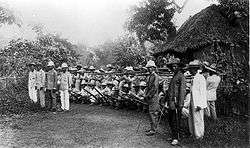
Filipino Soldiers outside Manila,1899.
-
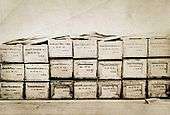
The coffins of fallen American Soldiers, (1906).
-

a World War II Propaganda poster of Philippine Army of its Resistance against the Japanese Invasion. (1941)
-
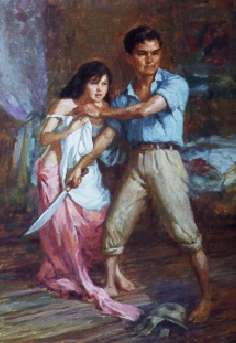
Defence of a Filipina Woman's Honour, A World War II Propaganda painting by Fernando Amorsolo
-

A Sherman tank in the Battle of Manila (1945)
-
.svg.png)
the flag of Federal Republic of Mindanao by Col. Alexander Noble, during 1990 Mindanao Crisis.
-
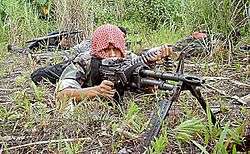
a Moro insurgent of the Islamic (Moro) insurgency at Mindanao.
-

Philippine Marine Private Damaranan rushes up a small ditch to engage role-playing enemy forces while Staff Sgt. John Ross of 31st Marine Expeditionary Unit provides communication during amphibious landing training of Balikatan Exercise.
See also
- Military history of the Philippines
- Warfare in pre-colonial Philippines
- List of wars involving the Philippines
References
- Notes
- ↑ Grace Estela C. Mateo. "The Philippines : A Story of a Nation" (PDF). Scholarspace.manoa.hawaii.edu. Retrieved 2015-08-28.
- 1 2 Scott, William Henry (1984). Prehispanic Source Materials. p. 74.
- ↑ Jobers Bersales (June 6, 2013), Raiding China, Inquirer.net
- ↑ Jobers Bersales, Raiding China at Inquirer.net
- ↑ Jovito Abellana, Aginid, Bayok sa Atong Tawarik, 1952
- ↑ Day, Tony & Reynolds, Craig J. (2000). "Cosmologies, Truth Regimes, and the State in Southeast Asia". Modern Asian Studies. Cambridge University Press. 34 (1): 1–55. doi:10.1017/S0026749X00003589. JSTOR 313111.
- ↑ History for Brunei 2009, p. 44
- 1 2 3 "Historical Timeline Of The Royal Sultanate Of Sulu Including Related Events Of Neighboring Peoplesby Josiah C". Seasite.niu.edu. 2000-08-30. Retrieved 2015-09-03.
- ↑ http://www.globalsecurity.org/military/world/philippines/history-ma-i.htm
- ↑
- Scott, William Henry (1994). Barangay: Sixteenth Century Philippine Culture and Society. Quezon City: Ateneo de Manila University Press. ISBN 971-550-135-4.
- ↑ del Mundo, Clodualdo (September 20, 1999). "Ako'y Si Ragam (I am Ragam)". Diwang Kayumanggi. Archived from the original on October 25, 2009. Retrieved 2008-09-30.
- 1 2 3 It was integrated to the Spanish Empire through pacts and treaties (c.1569) by Miguel López de Legazpi and his grandson Juan de Salcedo. During the time of their hispanization, the principalities of the Confederation were already developed settlements with distinct social structure, culture, customs, and religion.
- ↑ Halili, Christine N. (2004). "The Natural Setting and its People". Philippine History (First ed.). Manila, Philippines: Rex Book Store. pp. 52–53. ISBN 9712339343. Retrieved 29 April 2016.
- ↑ "Iloilo History Part 1 - Research Center for Iloilo". Ilongo.weebly.com. Retrieved 2015-09-17.
- 1 2 3 Lucoes warriors aided the Burmese king in his invasion of Siam in 1547 AD. At the same time, Lusung warriors fought alongside the Siamese king and faced the same elephant army of the Burmese king in the defence of the Siamese capital at Ayuthaya. SOURCE: Ibidem, page 195.
- ↑ Pigafetta, Antonio (1969) [1524]. "First voyage round the world". Translated by J.A. Robertson. Manila: Filipiniana Book Guild.
- 1 2 Gardner, Robert (1995-04-20). "Manila – A History". Philippine Journeys. Retrieved 2008-02-05.
- ↑ Scott 1992, pp. 50–53, notes 24 and 25 on pp. 62–63.
- ↑ Jerry Keenan (2001), Encyclopedia of the Spanish-American & Philippine-American wars, ABC-CLIO, p. 311, ISBN 978-1-57607-093-2
- ↑ "The Never Ending War in the Wounded Land: The New People's Army on Samar". University of Calgary. 12 November 2013.
- Bibliography
- Anderson, Benedict (2005), Under Three Flags: Anarchism and the Anti-Colonial Imagination, London: Verso, ISBN 1-84467-037-6
- Agoncillo, Teodoro C. (1990) [1960], History of the Filipino People (8th ed.), Quezon City: Garotech Publishing, ISBN 971-8711-06-6
- Aguinaldo y Famy, Emilio (1899), "Chapter II. The Treaty of Biak-na-bató", True Version of the Philippine Revolution, Authorama: Public Domain Books, retrieved 2008-02-07
- Aguinaldo y Famy, Emilio (1899), "Chapter III. Negotiations", True Version of the Philippine Revolution, Authorama: Public Domain Books, retrieved 2007-12-26
- Alvarez, Santiago V.; Malay, Paula Carolina S. (1992), The katipunan and the revolution: memoirs of a general: with the original Tagalog text, Ateneo de Manila University Press, ISBN 978-971-550-077-7, Translated by Paula Carolina S. Malay
- Batchelor, Bob (2002), The 1900s : American popular culture through history, Greenwood Publishing Group, ISBN 978-0-313-31334-9
- Blanchard, William H. (1996), Neocolonialism American Style, 1960-2000 (illustrated ed.), Greenwood Publishing Group, ISBN 978-0-313-30013-4
- Blair, Emma; Robertson, James (1903–1909), The Philippine Islands, 1493-1898, 1–55, Cleveland
- Bowring, Sir John (1859), A Visit to the Philippine Islands, London: Smith, Elder and Co.
- Constantino, Renato (1975), The Philippines: a past revisited, Self-published, Tala Pub. Services
- de Moya, Francisco Javier (1883), Las Islas Filipinas en 1882 (in Spanish), 1–55, Madrid
- Dav, Chaitanya (2007), Crimes Against Humanity: A Shocking History of U.s. Crimes Since 1776, AuthorHouse, ISBN 978-1-4343-0181-9
- Díaz Arenas, Rafaél (1838), Memoria sobre el comercio y navegacion de las islas Filipinas (in Spanish), Cádiz, Spain
- Gatbonton, Esperanza B., ed. (2000), The Philippines After The Revolution 1898-1945, National Commission for Culture and the Arts, ISBN 971-814-004-2
- Custodio, Teresa Ma; Dalisay, Jose Y. (1998), Reform and Revolution, Kasaysayan: The History of the Filipino People, 5, Asia Publishing Company Limited, ISBN 962-258-228-1
- Guevara, Sulpico, ed. (2005), The laws of the first Philippine Republic (the laws of Malolos) 1898-1899, Ann Arbor, Michigan: University of Michigan Library (published 1972), retrieved 2008-03-26 (English translation by Sulpicio Guevara)
- Halili, Maria Christine N. (2004). Philippine History. Manila: Rex Book Store. ISBN 978-971-23-3934-9.
- Halstead, Murat (1898), "XII. The American Army in Manila", The Story of the Philippines and Our New Possessions, Including the Ladrones, Hawaii, Cuba and Porto Rico
- Jagor, Feodor (1873), Travels in the Philippines (in German), Berlin: Weidmannsche Buchhandlung,
An English translation under this title was printed in London, 1875, by Chapman and Hall.
- Kalaw, Maximo Manguiat (1927), The Development of Philippine Politics, Oriental commercial, retrieved 2008-02-07
- Keat, Gin Ooi (2004), Southeast Asia: a historical encyclopedia, from Angkor Wat to East Timor, Volume 1, BC-CLIO, ISBN 978-1-57607-770-2
- Mabini, Apolinario (1969), "CHAPTER VIII: First Stage of the Revolution", in Guerrero, Leon Ma., The Philippine Revolution, National Historical Commission, Translated by Leon Ma. Guerrero.
- Montero y Vidal, Jose (1887–1895), Historia general de Filipinas (in Spanish), 1–3, Madrid: Imprenta de Manuel Tello
- Nelson-Pallmeyer, Jack (2005), Saving Christianity from empire, Continuum International Publishing Group, ISBN 978-0-8264-1627-8
- Regidor, Antonio M.; Mason, J. Warren (1905), Commercial Progress in the Philippine Islands, London: Dunn & Chidley
- Rodao, Florentino; Rodríguez, Felice Noelle, eds. (2001), The Philippine Revolution of 1896: Ordinary Lives in Extraordinary Times, Ateneo de Manila University Press, ISBN 978-971-550-386-0
- Salazar, Zeus (1994), Agosto 29-30, 1896: ang pagsalakay ni Bonifacio sa Maynila, Quezon City: Miranda Bookstore
- Seekins, Donald M. (1991), "Historical Setting—Outbreak of War, 1898", in Dolan, Philippines: A Country Study, Washington: Library of Congress, retrieved 2007-12-25
- Sagmit, Rosario S.; Sagmit-Mendosa, Lourdes (2007), The Filipino Moving Onward 5: Worktext in Geography, History, and Civics for Grade 5, RBS Social Studies (2007 ed.), Rex Bookstore, Inc., ISBN 978-971-23-4154-0
- Schumacher, John N. (1991), The Making of a Nation: Essays on Nineteenth-century Filipino Nationalism, Ateneo de Manila University Press, ISBN 978-971-550-019-7
- Titherington, Richard Handfield (1900), A history of the Spanish-American war of 1898, D. Appleton and Company
- Worcester, Dean Conant (1914), The Philippines: Past and Present (vol. 1 of 2), Macmillan, pp. 75–89, ISBN 1-4191-7715-X, retrieved 2008-02-07
- Zaide, Gregorio (1954), The Philippine Revolution, Manila: The Modern Book Company.
- Zaide, Gregorio F. (1957), Philippine Political and Cultural History: the Philippines Since the British Invasion, II (1957 Revised ed.), Manila: McCullough Printing Company
- Villahermosa, Gilberto N. (2009), Honor and Fidelity: The 65th Infantry in Korea, 1950-1953, Washington, D.C.: United States Army Center of Military History, retrieved 2010-11-09
- Chae, Han Kook; Chung, Suk Kyun; Yang, Yong Cho (2001), Yang, Hee Wan; Lim, Won Hyok; Sims, Thomas Lee; Sims, Laura Marie; Kim, Chong Gu; Millett, Allan R., eds., The Korean War, Volume II, Lincoln, NE: University of Nebraska Press, ISBN 978-0-8032-7795-3
- Chinese Military Science Academy (2000), History of War to Resist America and Aid Korea (抗美援朝战争史) (in Chinese), Volume II, Beijing: Chinese Military Science Academy Publishing House, ISBN 7-80137-390-1
- Hu, Guang Zheng (胡光正); Ma, Shan Ying (马善营) (1987), Chinese People's Volunteer Army Order of Battle (中国人民志愿军序列) (in Chinese), Beijing: Chinese People's Liberation Army Publishing House, OCLC 298945765
- War History Compilation Committee (1977), The History of the United Nations Forces in the Korean War, 6, Seoul: Republic of Korea Ministry of National Defense, OCLC 769331231
- This article incorporates public domain text from the Library of Congress July 1994, Retrieved on 11 November 2008

